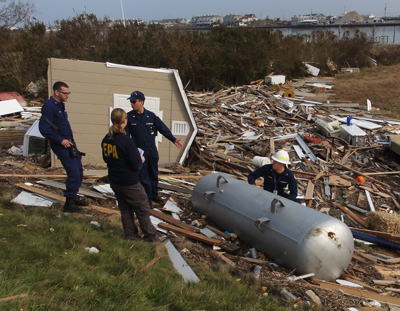Hurricane Sandy Response
Hurricane Sandy Response Efforts
Response timeline | November 10, 2012:
Water and Wastewater Utilities:

EPA and the Coast Guard assessed a private property in Rumson, NJ on November 10, 2012 and found an overturned propane tank in the debris.
New Jersey:
In response to requests from the New Jersey Department of Environmental Protection and municipalities, EPA is providing assistance in assessing drinking water and wastewater facilities across the state. To date, EPA has assessed 20 drinking water facilities and 15 wastewater treatment plants. Of these facilities, two wastewater treatment plants requested further assistance from EPA, and no drinking water facilities requested EPA assistance.
EPA is providing assistance to the Passaic Valley Sewerage Commission in Newark, New Jersey and the Middlesex County Utility Authority in Sayreville, New Jersey.
- The Passaic Valley Sewerage Commission receives sewage and industrial waste from 48 municipalities in and around Newark. It is the fifth largest wastewater treatment plant in the nation. During the storm, the plant was flooded and lost electricity. EPA is working in partnership with state and federal agencies to remove wastewater from the plant, restore power and find environmentally safe solutions for sludge disposal until the plant is back in full operation.
- During Hurricane Sandy, the Middlesex County Utility Authority lost power to its water utility intake pump. On November 6, 2012, power was restored. EPA is working with the utility and the state to fix damaged equipment.
New York:
In response to requests from the New York State Department of Environmental Conservation and municipalities, EPA is providing assistance in assessing drinking water and wastewater facilities across the state. To date, EPA has assessed 33 drinking water facilities and 12 wastewater treatment plants. None of these facilities required additional assistance from EPA.
Contaminated Sites:
In advance of Hurricane Sandy, EPA secured contaminated sites in the federal Superfund program in New Jersey and New York to protect against potential damage. Since the storm, EPA has been assessing these sites. All 105 of the short-term, removal sites have been assessed and do not pose an immediate threat to public health or the environment. Of the 142 long-term, remedial sites in the area, 96 assessments have been completed. EPA will continue to carry out this mission.
Several sites on the Superfund National Priorities List were impacted by the storm. EPA is continuing to assess conditions at the Gowanus Canal site in Brooklyn, New York, the Newtown Creek site on the border of Queens and Brooklyn, New York and the Raritan Bay Slag site in Laurence Harbor and Sayreville, New Jersey.
Gowanus Canal Sampling:
The Gowanus Canal is contaminated from many years of industrial discharges, spills, storm water runoff and combined sewer overflows. The site was added to the Superfund list in March 2010. In response to Hurricane Sandy, EPA immediately conducted a visual inspection of the length of the canal and the surrounding area and did not observe sediment on the streets.
On October 31, 2012, EPA took 4 samples in the Gowanus Canal area. Samples were taken from the ground floors of two buildings that had been flooded as well as directly from the canal. One of the buildings is located at the head of the canal, and the other near the 3rd street turning basin. Levels of bacteria were elevated, as would be expected with water carrying sewage, therefore precautions should be taken when cleaning flood waters. Additional chemicals that were tested were below levels of concern or not detected. For more details, visit https://www.epa.gov/region2/superfund/npl/gowanus/.
Debris Management:
EPA is working closely with the U.S. Army Corps of Engineers to develop and implement a plan on debris removal and will be working with New York State and local governments to collect household hazardous waste in Nassau and Suffolk counties in New York. EPA is also working closely with New York City and the Corps of Engineers to set up household hazardous waste collection operations in New York City.
Coastal Water Sampling:
On November 6, 2012, EPAs boat, The Clean Waters, was used to take water quality samples in coastal waters of New Jersey from Sandy Hook to Seaside Heights. There were 16 samples of ocean water collected 1-3 miles off the coast to determine potential impacts from the releases of raw sewage as a result of Hurricane Sandy.
The samples were analyzed for Enterococcus, a common group of bacteria associated with animal and human waste. The established limit for swimming is 104 bacteria colonies per 100 mL of water. Enterococcus levels from the EPAs samples were below this limit. Results of the sampling can be found at http://www.state.nj.us/dep/wms/bmw/sandyatlanticocean.html.
Response Timeline
Nov 2012 8 9 10 11 12 13 14 15 16 17 18 19 20 21 23 24 25 26 27 28 29 30
Dec 2012 1 2 4 6 8 10 12 14 17 18 27
Jan 2013 2 3 4 7 8 9 10 11 14 15 16 17 18 22 23 24 25 29 30 31
Feb 2013 1 4 5 6 7 8 12 13 14 20 21
March 2013 1 7
April 2013 11
